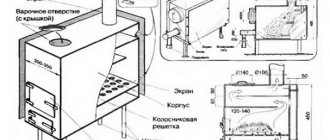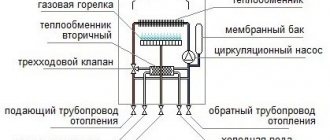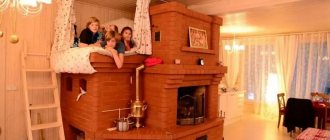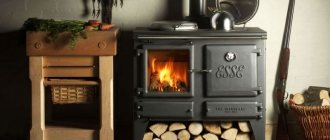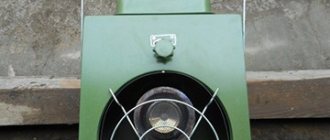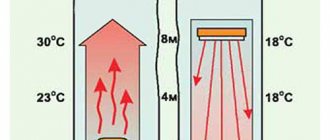Features of gas devices
The design running on natural gas differs from a gas boiler in that it does not require pipelines and radiators to heat residential premises. Makes it possible for sporadic operation of equipment in rooms where similar devices, with water as a coolant, may fail. The equipment does not contain a coolant that acts as an intermediary for the transfer of heat released during fuel combustion to the air in the room.
The lack of coolant does not allow the equipment to heat large houses. Usually enough for 50-70 sq. meters.
A gas stove for a summer residence consists of six elements:
- Frame. Can be made of heat-resistant steel, cast iron. The latter option is more durable, heat-intensive, is not afraid of corrosion, and often has a highly artistic decorative design. The disadvantage is the weight of cast iron (more than 150 kg), fragility, fear of overheating (when the furnace is heated to more than 500 degrees, crystalline deformation of cast iron occurs, the properties deteriorate sharply).
Models with a steel body can be placed in an additional brick shell to increase the heat capacity of the heating structure.
Gas stove for a summer residence with a heat exchanger.
Steel structures are lightweight, heat up and cool down quickly. Easy to install, affordable.
- The combustion chamber. A container with a burner where gas combustion occurs. The walls of the chamber heat up, the heat is transferred directly or through channels to the air in the heated room. A more complex design option is when the chamber is a symbiosis with a burner. Heat is transferred through a heat exchanger. The combustion chamber has a number of devices for supplying oxygen (blower) and removing combustion products, with manual or automatic control.
- Burner. No different from gas boiler burners. The minimum version has a bimetallic sensor. Most designs are equipped with an electronic regulation and temperature control system.
- Chimney. Various device options are possible - classic brick, coaxial. In the latter case, the choice of equipment installation location is expanded; the construction of a chimney is not required.
It is easier to equip a heating stove installed in a country house with a chimney made of light metal pipes. They are easy to install and reliable. Structurally, the pipes are a three-layer sandwich: the outer and inner ones are made of heat-resistant metal, with non-flammable thermal insulation between them.
- Heat exchange system. The circulating air heats up and returns to the room.
- Control block. Complex, programmable device. The block takes into account the state of the environment indoors and outdoors. It can change the intensity of gas combustion and the amount of heat generated. The power adjustment range is from 1% to 100% (in 1% increments).
If the cottage is regularly visited, it is recommended to equip the heating stove with a control unit. You can turn on the heating before arriving via the Internet, switch the heating to a minimum that does not require large gas costs and prevents the building from freezing.
Installation diagram
Choosing a gas stove for a private home
When choosing a suitable stove for a country house, pay attention to the following indicators:
- To maintain the required temperature in the house, the device must be selected correctly in terms of power. In this case, it is necessary to take into account the heated area, the quality of insulation of the house, the number of windows and doors, and the degree of thermal insulation of the roof.
- The configuration of the device is important for ease of use and management. When choosing this option, consider the type of fuel you plan to use. Combined models have different adapters to operate on different fuels.
- Based on the method of obtaining thermal energy, such devices are divided into catalytic and units with burners. The first type is recommended for use in houses with a small area.
- Single-stage burners are the simplest. They can be turned on and off manually. Two-stage burners save up to 40 percent of fuel and operate in automatic mode. Devices with smooth adjustment are the most expensive, but they quickly switch between different modes of supplying thermal energy.
- Based on the type of oxygen supply to the furnace, units with atmospheric and fan type burners are distinguished. In the first case, air enters the combustion chamber from the room. The efficiency of such a device reaches 90%. A forced air system is used to force air into the fan burner. The efficiency of this type is 95%.
- There are stoves with open and closed combustion chambers. The first type requires the installation of a traditional chimney. A coaxial chimney is used to remove combustion products from a closed chamber.
Attention! Choose only units intended for residential use. It is good if the device has a sensor to determine the level of carbon dioxide. If the content of hazardous substances increases, the device automatically turns off.
Advantages and disadvantages
Positive traits:
- Compared to electricity, diesel fuel, coal, gas is cheaper.
You can understand the costs of heating with wood using simple calculations. In the middle zone, heating a wooden house made of rounded logs requires a volume of birch firewood 1.5-2.5 times greater than the volume of the house.
- High heating efficiency. The efficiency factor (COP) of gas furnaces exceeds 85%. For comparison, the efficiency of most designs operating on solid fuel is 40% - 70%.
- Quick commissioning. A stove unit operating on gas begins to heat the room after a few minutes of routine inspection, checking the functionality of the mechanisms (blower, burner, pipes, gas supply pipes, valves)
- Low labor costs for maintenance. The designs are equipped with regulating mechanisms that allow you to use the heating device in the “turn it on and forget it” mode.
- Safety. Household gas has been used for more than half a century. During this time, it was found that gas equipment is safer than its solid fuel counterparts.
Carbon monoxide released during improper operation of a wood or coal stove is practically undetectable without equipment. You can feel it when you start to get poisoned. This is not possible with natural gas due to odor additives. The slightest leak can be easily diagnosed.
Timberk heater with cylinder
Negative characteristics:
- High cost of the heating device and components.
- Dependence on one type of fuel. The main gas supply may be unstable. Refilling gas cylinders takes time. The problem can be solved by purchasing a multi-fuel boiler.
If the transition from solid fuel to gas requires the help of gas workers, the reverse operation is within the power of any householder. A set of parts is required (grid bars, doors, ash box). Switching the stove will take no more than an hour and a half.
- The need to contact the organization (connection to the main gas pipeline). The disadvantage stems from legal requirements; independent installation of equipment can lead to injury and death. If a portable gas cylinder is used, the owner decides where to place the stove, connect the cylinder, and ensures safe operation.
- Compliance with safety rules when operating gas equipment. The rules protect the health and property of the homeowner.
Gas infrared heater Neoclima UK-10
Installation of gas furnaces
Connecting gas devices to a centralized gas pipeline will not be cheap, and not all owners of private houses can afford it. Therefore, if the building is not yet connected to the gas main, then it is worth considering other options for creating heating or buying cylinders (more details: “Heating a house with gas cylinders is a simple old-fashioned solution”). If gas is already supplied to the site, then installing a heating system will cost much less.
After a gas heating unit has been installed in the house, it is necessary to check the operation of the equipment. Any errors during the installation process can negatively affect the comfort in the home and heating efficiency. In addition, gas equipment, if installed incorrectly, can cause harm to humans - natural gas is a dangerous fuel, and this should not be forgotten.
Types of furnaces
Equipment for a country house can be divided into several types:
- heat capacity;
- material;
- appointment;
- fuel.
By heat capacity level
Heat capacity is an important parameter that depends on the material of the heating device body. Steel cases have the minimum heat capacity. The stove will quickly heat up and heat the dacha, but as soon as the gas supply is stopped, the equipment will cool down.
Heating design "Titan 20U"
Cast iron bodies are more heat-intensive. Structures lined with brick are most effective. They warm up more slowly, but after the gas combustion stops they continue to give off heat to the room. They use fuel economically.
By material
The material of the stove affects durability and price. Cheap ones are steel stoves, expensive ones are cast iron. The cost of equipment using brick (as a heat accumulator, heat exchanger material) exceeds cast iron; assembly requires the involvement of a stove-maker.
The durability of steel furnaces is at least 15 years. With proper care they will last more than 20 years. The service life of cast iron stoves is more than 45 years. Structures based on steel and brick will last 20 - 30 years.
By purpose
The purpose of the equipment is to heat the cottage. It can be constant throughout the heating season, cyclic - 2-3 days a week or month. It is worth mentioning the possible use of ovens for cooking food or heating water. Ovens are sometimes equipped with a hob and a small heating tank.
The oven should not be considered a replacement for a kitchen stove. The maximum you can get is to boil water and warm up cold snacks. Careless handling of cast iron structures leads to damage: cracking, chipping (from cold water or impacts).
By fuel type
Heating a dacha with gas cylinders
Gas can be mainline or cylinder. The composition is different, but the calorific properties are the same. It is important to remember about safe placement and equipping with a working pressure reducer.
The equipment is equipped with universal burners that can operate from a main line or a cylinder. Before purchasing, you must check the properties using the accompanying documents.
Operating principle of a gas heater
The operation of a gas stove is based on the same principle as that of wood-burning boilers. However, water or other liquid is not used as a coolant. In this case, heating occurs due to the convection movement of cold and hot air layers, and it is not wood that burns in the firebox, but natural gas mixed in certain proportions with oxygen.
If necessary, the purchased stove can be integrated into the existing water heating system of the dacha, as well as connected to a heated air distribution system in adjacent rooms.
Combination boiler for heating a cottage
There are also combined systems:
The latter varieties are the most effective. The system, equipped with an additional gas burner, does not cool down during pauses between firing, as a result of which the temperature in the rooms is kept at a comfortable level throughout the entire period of use (and does not cool down at night, when the boiler is not heated with coal or briquettes).
The best model for a summer residence
Without knowing the situation, it is difficult to recommend a specific model. To avoid mistakes, you need to make a choice based on objective criteria.
Criterias of choice
When choosing equipment you need to consider:
- Power. For 10 sq. meters of living space should generate 1 kW per hour. You need to add 20% to the resulting number in case of unforeseen situations. For example, for a dacha with an area of 60 square meters. meters you will need a furnace with a power of 7-8 kW.
- Method of heat generation. Classic - through burners, or catalytic. Depends on the area of the room and the duration of heating. For country houses up to 30 sq.m. meters visited occasionally, catalytic gas heaters are suitable. The high cost will quickly pay off with ease of operation, efficiency, and mobility. If the area is larger and people stay longer, it is worth using devices with classic burners.
- Absence or presence of burners, their type. Catalytic heaters do not have burners. There can be three types.
Single-stage burners are reliable and cheap. Non-volatile, not economical. There is no possibility of adjustment.
Two-stage devices are more expensive. In addition to the main mode, they can operate at half power. Often require an external power source. More economical.
Burners with smooth adjustment. Range - 1% - 100% power. Equipped with a sophisticated electronics unit. Energy dependent. Expensive, but economical and efficient in gas consumption.
- Mechanism for providing burners with air. The classic option is through a blower, naturally (stove efficiency is no more than 90%). A more modern one (with adjustable burners) is forced, with a built-in high-speed turbine. Makes the air flow dependent on power supply, increases the efficiency of the heating device to 94-95%.
- Combustion chamber design. Most often the camera is an open type. It receives air from the heated room. A closed chamber is technically more complex, but more convenient. Air to support combustion is taken from outside the room. Living rooms are not deprived of oxygen; the ingress of combustion products in the event of equipment failure is completely excluded.
Ballu BIGH-55H 4200 W
Manufacturers
More than 30 world-class manufacturers are represented on the Russian market. Popular:
- Ballu,
- Hyundai
- Hosseven,
- NeoClima,
- Remington,
- Timberk.
Cost - 1500 - 15000 rubles (as of July 2021). Power up to 6 kW. Catalytic type devices. Some require electricity. The general property is economical gas consumption, quick heating of rooms up to 20 square meters. meters.
For long-term heating of large buildings, manufacturers’ models are often purchased:
- Teplodar,
- Elitech.
The products are powered by gas mains and cylinders. The use of solid fuel, automation, and control of the composition of the atmosphere of the heated room are provided. Cost as of July 2019 - 10 - 30 thousand rubles
How to choose a heating system
A private house or cottage must be fully heated to make it comfortable to stay in at any time of the year. To choose the appropriate heating system option, you can read reviews, literature and seek advice from specialists.
If there is no centralized heating system, then a gas stove for the house can be installed, but only if it has no more than two floors. Such equipment can operate in both temporary and permanent modes. In the firebox of the furnace there is a gas burner, in which the combustion of fuel occurs. At the top of the firebox there is a grate made of heat-resistant brick.
During the operation of a gas furnace, the grate is heated, and the heat flows to the walls of the firebox. This ensures uniform heating of the air. If you install gas burners in the firebox at the lower level, the lower masonry of the stove will warm up more efficiently, and accordingly, the volume of the firebox will be used more wisely.
READ How to set up a 404 page on Yukoz
The firebox of a gas furnace in the upper part borders on the chimneys, and in the lower part it communicates with the blowers. Through this element, air enters gas stoves for the home, without which combustion of fuel becomes impossible.
There is a small hole in the ash door for switching the stove to gas. If the operation of the device is not constant, then it is necessary to build a firebox from refractory bricks. A red brick firebox can only be made if the stove will operate year-round. Stove flues must be installed in a shield (pro
Methodology for calculating fuel consumption
Connecting the stove to the cylinder
The amount of gas per month can be calculated using the formula:
Equipment power (kW) x 0.112 (how many cubic meters of gas need to be burned to generate 1 kW), multiply the resulting number by 720 (the number of hours in a month).
For example, for a dacha with an area of 70 square meters. meters you need a design with a power of at least 9 kW. It will burn at least 725 cubic meters of gas per month (with round-the-clock operation).
Gas stove heating and what is it?
In terms of practicality and economy, gas stoves are only slightly inferior to solid fuel stoves. In gas stoves, the heat source is the burner flame, which is mounted in the combustion chamber. If the device operates on bottled gas, then the container can be filled at any gas station.
To save fuel and automatically regulate the operation of the unit, a control system is installed. Thanks to it, you can maintain a constant temperature in the room. Using a gas stove, you can equip your home with water heating. To do this, you need to install a coil with circulating coolant inside. The most popular are combination stoves that can operate on different types of fuel.
Advantages and disadvantages
A gas stove for home has the following advantages:
- When using bottled gas, you can enter into an agreement with the gas service on regular refilling of the container. This way you will be sure that you will not forget to refill the empty cylinder.
- A gas stove allows you to save a lot, because gas is much cheaper than electricity.
- Modern models of such furnaces are characterized by economical fuel consumption and high efficiency.
- To control the operation of the equipment, you can install a special system. This will allow you to control the operation of the device from a distance using a mobile phone.
- Only carbon dioxide is produced as a combustion product, so the chimney does not need to be cleared of soot.
- Thanks to its energy independence, the device can be used in areas with power outages.
- To install the unit, you do not need to allocate a separate room, as well as a place for storing fuel.
- Simple operation and minimal maintenance are additional advantages of stove heating.
- The warranty period for such devices is 10 years, but in practice they will last even longer.
The disadvantages of stove gas heating are as follows:
- if you compare a gas heating stove with solid fuel appliances, then the costs of purchasing fuel are required, while firewood can be prepared independently;
- when connecting the stove to the main gas, you need to order a project from a licensed organization and get approval from the gas service;
- After connecting to the main gas network, the system must pass acceptance.
Features of operation
When using a gas stove to heat your dacha, you should remember to insulate the building.
You need to insulate the walls, floor, and ceiling. To streamline your work, you should use a thermal imager. It will help identify ways of heat leakage from the building.
Burner models require a pipe to remove combustion products. A regular pipe for a wood stove without modification is unsuitable. The chimney is no less important part of the heating system than the stove. To avoid unnecessary expenses and health risks, it is recommended to invite a specialist for design and installation.
Furnaces with a brick heat accumulator require a strong base (average weight - 1000-1500 kg).
Cast iron gas stove for a summer residence
Homemade stoves for a summer residence
One of the serious stopping factors, which is why many users do not dare to acquire a convenient gas stove, is the high cost of such equipment. However, if you have certain skills in construction, this problem can be solved by reconstructing a conventional wood-burning stove made of brick. The conversion process itself is not very complicated: you need to put a burner in the firebox and make changes to the design of the chimney. This will allow you to switch to continuous operation to maintain a stable temperature in the house.
Thanks to the additional installation of an automation kit, the once primitive stove is transformed into an autonomous heating device. If the draft suddenly disappears, the temperature rises sharply or there are interruptions in the gas supply, the fuses will trip and the furnace will stop working. The main difficulty of such a design solution lies in the labor-intensive process of remaking the chimney.
For the technical possibility of supplying gas, it is necessary to ensure high-quality removal of combustion products in accordance with the requirements of the gas service. Whether it is necessary to start such a complex enterprise at a dacha with seasonal residence is decided by the owner of the house himself. Judging by practical experience, it is more convenient to equip such houses with ready-made models.
About security
Safety regulations:
- Check the equipment for correctness and trouble-free operation (not personally, but with the help of a specialist) before the heating season.
- Place gas cylinders away from the structure.
- When using cylinders, use a gas reducer. Check the cylinder regularly for strength.
- Place the oven on a non-flammable, solid base. In wooden buildings, reliably isolate the heating device and chimney from flammable walls and ceilings.
- Watch for gas leaks. If suspicious odors or sounds appear, stop using the device and contact the gas service.
Device classification
Gas boilers are widely used for heating private houses. They have proven themselves well in dachas. Most often, factory systems are purchased, designed for certain conditions of use. However, upon request, you can also make the stove out of brick.
Heat production method
According to this criterion, gas heating stoves are divided into several types:
| System | Description |
| With combustion chamber | Gaseous fuel enters a special device, where it burns, thereby heating the walls. The air, passing through special openings and coming into contact with the surfaces mentioned above, heats up, increasing the temperature in the room. |
| With heat exchanger | The gas is supplied to a special spiral made of a heat-resistant pipe, which serves as a kind of heat exchanger. |
Photo of a gas boiler with a heat exchanger
Heat capacity
This is another indicator that characterizes various models of gas stoves for heating cottages. He talks about the device’s ability to accumulate the thermal energy it creates.
There are two main options:
Brick gas stove for heating
The heat accumulator is usually brick, which is used according to the following schemes:
- heat-conducting channels are laid out with it;
- the gas combustion chamber is lined;
- heating shields are manufactured.
This option is widely used for heating private houses and baths.
